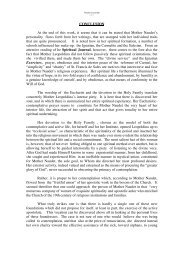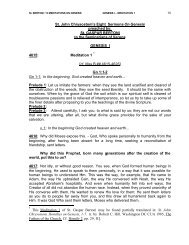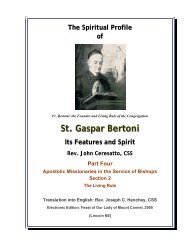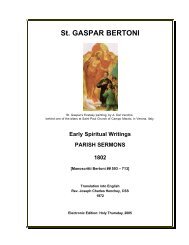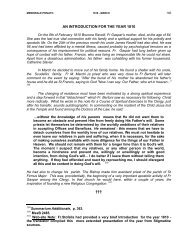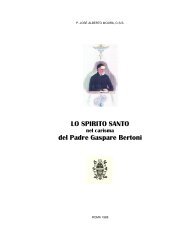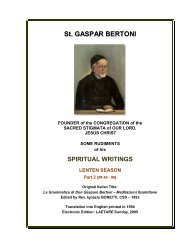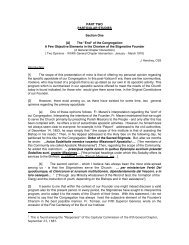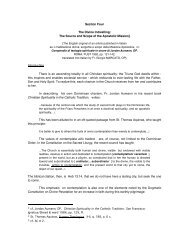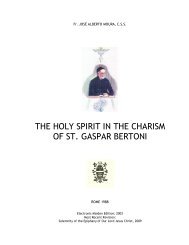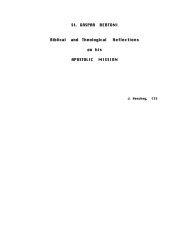[B.] St. IGNATIUS of LOYOLA Presentation: The ... - St. Gaspar Bertoni
[B.] St. IGNATIUS of LOYOLA Presentation: The ... - St. Gaspar Bertoni
[B.] St. IGNATIUS of LOYOLA Presentation: The ... - St. Gaspar Bertoni
Create successful ePaper yourself
Turn your PDF publications into a flip-book with our unique Google optimized e-Paper software.
INTEGRE;SJ-OFM<br />
= 16 =<br />
over from desolation, loneliness, to consolation. <strong>The</strong> person who unites with Mary experiences<br />
this presence <strong>of</strong> the Risen Lord in life. <strong>The</strong> saint has us enter into such experiential<br />
understanding in freedom and fidelity. Only an understanding <strong>of</strong> lived and hopeful faith can lead<br />
one to serve the Church for a lifetime.<br />
[e] In the light <strong>of</strong> the resurrection <strong>of</strong> her Son, Mary<br />
inaugurates the new type <strong>of</strong> understanding the faith which will be the patrimony <strong>of</strong> the nascent<br />
Church. In the moment <strong>of</strong> the glory <strong>of</strong> the resurrection, Mary is one with the Church [cf. Ac 1:12-<br />
14] - which Jesus Christ has entrusted to His Apostles. In her one can become united in a unique<br />
manner to the Paschal Mystery, and in this way the faith in the Church is generated and<br />
communicated.<br />
[f] <strong>The</strong> understanding <strong>of</strong> the Scriptures, the Gift <strong>of</strong><br />
the Spirit, and Mary: these are three realities that are intimately interwoven throughout the<br />
unfolding <strong>of</strong> that Fourth Week <strong>of</strong> the Spiritual Exercises. Ignatius begins to contemplate from this<br />
very composition <strong>of</strong> the initial place which consists in the passing over from the disposition <strong>of</strong> the<br />
sepulcher to the House <strong>of</strong> Our Lady [cf. SE # 220]. Concerning this coming to the “House <strong>of</strong><br />
Mary”, a figure <strong>of</strong> the Church, the spiritual understanding <strong>of</strong> the Scripture is the Gift <strong>of</strong> the Spirit<br />
which the Church receives in the moment in which the Risen One, her Son, meets with Mary.<br />
[2] Ignatius’ Conversion through the Risen Lord to Total<br />
Commitment to the Apostolic Mission <strong>of</strong> the Church:<br />
[a] For this reason, there can be little surprise in accepting<br />
the person <strong>of</strong> Mary as symbolically the culmination <strong>of</strong> the entire spiritual process. In similar<br />
manner, as for the Grand Journey <strong>of</strong> Jesus, ever towards Jerusalem, <strong>St</strong>. Ignatius follows this step<br />
by step, noting the historical Jesus all the way up to the moment <strong>of</strong> His death on the Cross.<br />
Jesus is followed right through to Jerusalem.<br />
[b] However, at a given moment <strong>of</strong> Ignatius’ life, Rome<br />
comes to occupy for him the end <strong>of</strong> his own pilgrimage. Rome for him is definitively the New<br />
Jerusalem, whence he looks upon the faith <strong>of</strong> Mary received in the Spirit in her Risen Son, and<br />
she then becomes the exemplary Model <strong>of</strong> the Faith <strong>of</strong> the Church obedient to God.<br />
[c] From the reception <strong>of</strong> the Word and by the fulfillment <strong>of</strong><br />
the salvific will <strong>of</strong> God, the Church is born, the Spouse <strong>of</strong> Christ, constituted in conformity with<br />
the Gift <strong>of</strong> the Holy Spirit, by the ecclesial communion, for the apostolic mission. With the<br />
appearance <strong>of</strong> the Risen Lord to Mary we find ourselves consequently before the theological<br />
foundation <strong>of</strong> the specific discernment <strong>of</strong> the Fourth Week: to consider the Church as the<br />
Spouse <strong>of</strong> Christ, led by the Spirit <strong>of</strong> God beginning with the moment <strong>of</strong> the Ascension.<br />
[cf. Ac 1:4].<br />
[3] <strong>The</strong> Ascension and Ignatius’ Conversion to the Apostolic<br />
Mission:<br />
[a] For Ignatius, the Lord’s Ascension was connected<br />
closely to his own desire for the Holy Places. His idea was to imitate even materially Jesus Christ<br />
even in the minimal details, and to consider these simply as elements on his way <strong>of</strong> his following<br />
<strong>of</strong> Christ - the horizon <strong>of</strong> which was still in the Plan <strong>of</strong> God. He was making the leap from the<br />
‘particular’ place, the Holy City <strong>of</strong> Jerusalem - to the Spiritual Jerusalem, the Universal Church<br />
under the guidance <strong>of</strong> the Holy Spirit.<br />
[b] <strong>The</strong> Ascension meant for him that final point <strong>of</strong> the<br />
Fourth Week. This opened up, through the Contemplation toward Love, to the daily monotony<br />
and routine <strong>of</strong> the living <strong>of</strong> the Constitutions, using as his horizon his life in and for the Church.<br />
This meant the disappearance <strong>of</strong> the visible Jesus <strong>of</strong> Nazareth Who gave the beginnings <strong>of</strong> the<br />
Apostolic Mission, beginning with the humble, but vital apostolate <strong>of</strong> teaching catechism to the<br />
rudes, in an around the Gesu’ in Rome. This all began and was inspired by the experience <strong>of</strong>


![[B.] St. IGNATIUS of LOYOLA Presentation: The ... - St. Gaspar Bertoni](https://img.yumpu.com/33393889/16/500x640/b-st-ignatius-of-loyola-presentation-the-st-gaspar-bertoni.jpg)
